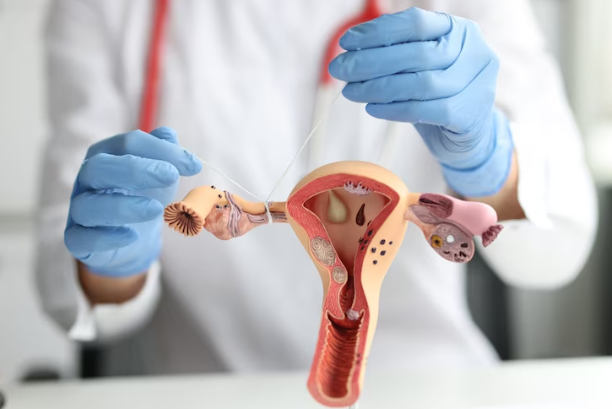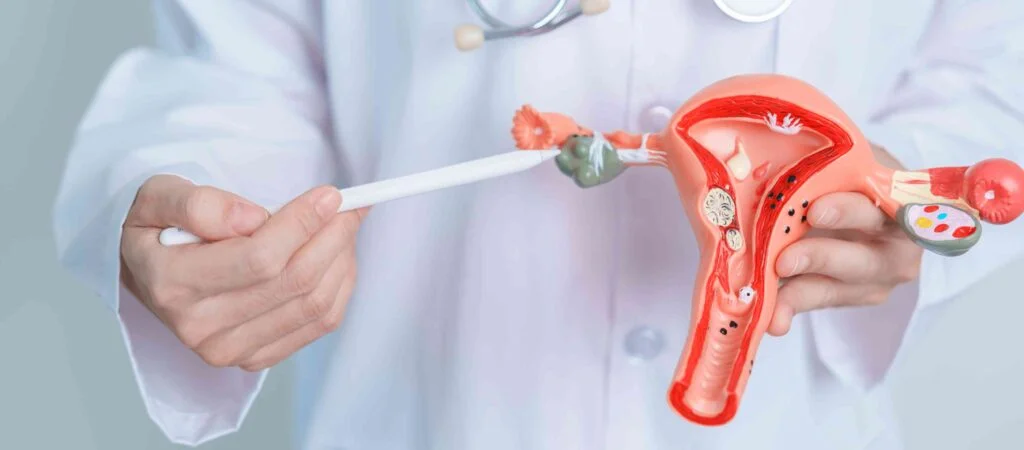Blocked fallopian tubes (tubal occlusion) can prevent sperm and egg from meeting and may cause infertility or increase ectopic pregnancy risk. Causes include prior pelvic infections (e.g., chlamydia, gonorrhea), endometriosis, prior surgery, pelvic inflammatory disease (PID), fibroids, and adhesions. Treatment depends on the blockage site (proximal near the uterus vs. distal near the ovary), severity (partial vs. complete), and overall fertility factors (age, ovarian reserve, sperm quality).
Diagnosis
- History and exam: Prior PID, STIs, surgeries, endometriosis, infertility duration.
- Imaging:
- Hysterosalpingography (HSG): X-ray dye test to assess tubal patency and uterine cavity; sometimes clears minor mucus plugs or spasms.
- Sonohysterography/HyCoSy: Ultrasound contrast to visualize flow; less radiation.
- Laparoscopy with chromopertubation: Gold standard for direct visualization; dye injected through the uterus to see spill from tubes; allows simultaneous treatment.
- Pelvic ultrasound/MRI: Evaluate fibroids, hydrosalpinx, endometriosis.
- Labs: STI screening, ovarian reserve (AMH, AFC), hormonal profile.
Understanding Blockage Types
- Proximal occlusion (near uterine cornua): Often due to mucus plugs, spasm, small polyps, or scarring.
- Distal occlusion (near fimbriae): Commonly from adhesions, hydrosalpinx (fluid-filled tube), or endometriosis.
- Unilateral vs. bilateral: One or both tubes affected.
- Hydrosalpinx: Distended tube with toxic fluid that lowers IVF success; usually requires surgical management.
Treatment Options
Non-surgical/Conservative

- Antibiotics: For active infections; prevents further damage but does not reverse scarring.
- HSG “flush”: The dye or foam during HSG/HyCoSy may open minor functional blockages; a short-term bump in fertility can occur.
- Tubal flushing with oil-based contrast: Some evidence suggests improved short-term pregnancy rates in select patients.
Minimally Invasive Procedures
- Selective tubal cannulation (for proximal block): A catheter is passed through the uterus into the tube under X-ray (fluoroscopy) or hysteroscopic guidance to clear plugs or mild scarring. High success in restoring patency for proximal occlusion.
- Hysteroscopic treatment: Removal of endometrial polyps or submucous fibroids that may obstruct the tubal ostia.
Surgical Options
- Laparoscopic adhesiolysis and fimbrioplasty (distal block): Freeing adhesions around the tube/ovary and reconstructing the fimbriae to restore function. Best outcomes in mild to moderate disease.
- Salpingostomy/Salpingotomy: Creating or opening the distal end; risk of re-occlusion and ectopic pregnancy.
- Salpingectomy (removal of tube): Recommended for severe hydrosalpinx or irreparable tubes, especially before IVF to improve success rates.
- Endometriosis surgery: Excision/ablation of endometriotic lesions and adhesions to improve fertility.
Assisted Reproductive Technologies (ART)

- Intrauterine insemination (IUI): Only if at least one tube is open and other factors are favorable; not effective for bilateral blockage.
- In vitro fertilization (IVF): Bypasses tubes entirely; preferred for bilateral occlusion, severe distal disease, or after failed tubal surgery. Salpingectomy or proximal tubal occlusion may be recommended beforehand if hydrosalpinx is present.
Choosing the Right Path
- Age and ovarian reserve: Older age or diminished reserve often favors IVF sooner.
- Blockage location: Proximal—consider cannulation; distal—consider laparoscopy or IVF depending on severity.
- Extent of disease: Mild adhesions may benefit from surgery; severe damage often performs better with IVF.
- Sperm quality and uterine factors: Address male factor infertility, fibroids, or uterine anomalies concurrently.
- Desire for multiple children: Tubal repair may allow natural conception over time; IVF offers controlled planning but may be repeated.
Risks and Considerations
- Ectopic pregnancy: Higher after tubal surgery or with residual tubal disease; early monitoring of pregnancy is essential.
- Re-occlusion: Tubes can scar again; success declines with severity and time.
- Surgical risks: Bleeding, infection, organ injury, anesthesia risks.
- IVF risks: Ovarian hyperstimulation, multiple pregnancy if not carefully managed, procedural discomfort.
Recovery and Aftercare
- After cannulation or laparoscopy: Usually same-day or overnight; mild cramping and spotting; resume light activity in a few days.
- Pelvic floor and pain management: Gentle exercise, NSAIDs if appropriate.
- STI prevention: Screen and treat partners; condom use to prevent reinfection.
- Timed intercourse/IUI: Try conception in the months after successful tubal opening if appropriate.
- Follow-up: Repeat imaging if symptoms persist; early transvaginal ultrasound at 5–6 weeks if pregnant to rule out ectopic.
Success Rates (Approximate, vary by center and patient factors)
- Proximal cannulation: Patency 60–90%; pregnancy rates 20–60% depending on age/time trying.
- Distal reconstructive surgery: Pregnancy 20–40% in mild/moderate disease; lower in severe disease; ectopic risk 5–15%.
- IVF: Per-cycle live birth rates depend on age (e.g., 40–50% under 35, declining with age); improved after treating hydrosalpinx with salpingectomy.
Cost and Access
- Imaging and cannulation often outpatient; surgery requires an operating room.
- IVF costs vary widely and may be covered partially by insurance in some regions; surgical repair may be cost-effective in younger, mild disease.
- Choose experienced reproductive surgeons/interventional radiologists; outcomes improve with expertise.
Lifestyle and Prevention Tips
- STI prevention and prompt treatment to reduce PID risk.
- Smoking cessation: Smoking worsens tubal and fertility outcomes.
- Maintain healthy weight and manage conditions like endometriosis early.
- Optimize overall fertility: Prenatal vitamins, limit alcohol, manage stress, and track ovulation.
FAQ
How do I know if my tubes are blocked?
Many women have no symptoms. Infertility workup with HSG/HyCoSy or laparoscopy confirms blockage. Hydrosalpinx may cause pelvic pain or watery discharge.
Can HSG open blocked tubes?
Sometimes. The pressure and contrast can clear minor functional blockages, especially proximally. It won’t fix significant scarring or distal adhesions.
Is surgery or IVF better?
It depends on age, severity, and location of blockage. Mild disease in younger patients may benefit from surgery; severe or bilateral disease often does better with IVF. Hydrosalpinx generally warrants salpingectomy before IVF.
What is hydrosalpinx and why is it important?
A fluid-filled, damaged tube that lowers IVF success and can cause miscarriage. Removing or occluding the tube before IVF improves outcomes.
What are the ectopic pregnancy risks after tubal repair?
Higher than baseline (5–15% depending on disease and procedure). Early pregnancy ultrasound is critical to confirm intrauterine location.
Can lifestyle changes help unblock tubes?
They won’t reverse scarring, but preventing infections, quitting smoking, and managing endometriosis can protect tubal health and improve fertility prospects.
How soon can I try to conceive after treatment?
Often within the first few cycles after successful cannulation or surgery, once cleared by your doctor. After IVF preparation, timelines depend on protocols.

